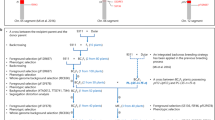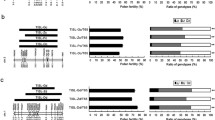Abstract
Key message
Pyramiding of S5 - n and f5 - n cumulatively improved seed-setting rate of indica–japonica hybrids, which provided an effective approach for utilization of inter-subspecific heterosis in rice breeding.
Abstract
Breeding for indica–japonica hybrid rice is an attractive approach to increase rice yield. However, hybrid sterility is a major obstacle in utilization of inter-subspecific heterosis. Wide-compatibility alleles can break the fertility barrier between indica and japonica subspecies, which have the potential to overcome inter-subspecific hybrid sterility. Here, we improved the compatibility of an elite indica restorer line 9311 to a broad spectrum of japonica varieties, by introducing two wide-compatibility alleles, S5-n and f5-n, regulating embryo-sac and pollen fertility, respectively. Through integrated backcross breeding, two near isogenic lines harboring either S5-n or f5-n and a pyramiding line carrying S5-n plus f5-n were obtained, with the recurrent parent genome recovery of 99.95, 99.49, and 99.44 %, respectively. The three lines showed normal fertility when crossed to typical indica testers. When testcrossed to five typical japonica varieties, these lines allowed significant increase of compatibility with constant agronomic performance. The introgressed S5-n could significantly improve 14.7–32.9 % embryo-sac fertility in indica–japonica hybrids. In addition, with the presence of f5-n fragment, S5-n would increase the spikelet fertility from 9.5 to 21.8 %. The introgressed f5-n fragment greatly improved anther dehiscence, embryo-sac and pollen fertility in indica–japonica hybrids, thus leading to improvement of spikelet fertility from 20.4 to 30.9 %. Moreover, the pyramiding line showed 33.6–46.7 % increase of spikelet fertility, suggesting cumulative effect of S5-n and f5-n fragment in seed-set improvement of inter-subspecific hybrids. Our results provided an effective approach for exploiting heterosis between indica and japonica subspecies, which had a profound implication in rice breeding.





Similar content being viewed by others
References
Chen S, Lin X, Xu C, Zhang Q (2000) Improvement of bacterial blight resistance of ‘Minghui 63’, an elite restorer line of hybrid rice, by molecular marker-assisted selection. Crop Sci 40:239–244
Chen S, Xu C, Lin X, Zhang Q (2001) Improving bacterial blight resistance of ‘6078’, an elite restorer line of hybrid rice, by molecular marker-assisted selection. Plant Breed 120:133–137
Chen J, Ding J, Ouyang Y, Du H, Yang J, Cheng K, Zhao J, Qiu S, Zhang X, Yao J, Liu K, Wang L, Xu C, Li X, Xue Y, Xia M, Ji Q, Lu J, Xu M, Zhang Q (2008) A triallelic system of S5 is a major regulator of the reproductive barrier and compatibility of indica–japonica hybrids in rice. Proc Natl Acad Sci USA 105:11436–11441
Chen L, Zhao Z, Liu X, Liu L, Jiang L, Liu S, Zhang W, Wang Y, Liu Y, Wan J (2011) Marker-assisted breeding of a photoperiod-sensitive male sterile japonica rice with high cross-compatibility with indica rice. Mol Breed 27:247–258
Chen H, Xie W, He H, Yu H, Chen W, Li J, Yu R, Yao Y, Zhang W, He Y, Tang X, Zhou F, Deng X, Zhang Q (2014) A high-density SNP genotyping array for rice biology and molecular breeding. Mol Plant 7:541–553
Gu M, Pan X, Chen Z, Yang W (1991) A study on compatibility of standard wide compatibility testers of rice in China (in Chinese with English abstract). Sci Agric Sin 24:27–32
Ikehashi H, Araki H (1984) Variety screening of compatibility types revealed in F1 fertility of distant crosses in rice. Jpn J Breed 34:304–313
Ikehashi H, Araki H (1986) Genetics of F1 sterility in remote crosses of rice. In: IRRI (ed) Rice genetics. IRRI, Malina, pp 119–130
Jeon JS, Jung KH, Kim HB, Suh JP, Khush GS (2011) Genetic and molecular insights into the enhancement of rice yield potential. J Plant Biol 54:1–9
Khanna A, Sharma V, Ellur RK, Shikari AB, Gopala Krishnan S, Singh UD, Prakash G, Sharma TR, Rathour R, Variar M, Prashanthi SK, Nagarajan M, Vinod KK, Bhowmick PK, Singh NK, Prabhu KV, Singh BD, Singh AK (2015) Development and evaluation of near-isogenic lines for major blast resistance gene(s) in Basmati rice. Theor Appl Genet 128:1243–1259
Kumar RV, Virmani SS (1992) Wide compatibility in rice (Oryza sativa L.). Euphytica 64:71–80
Li H, Wang J, Liu A, Liu K, Zhang Q, Zou J (1997) Genetic basis of low-temperature-sensitive sterility in indica–japonica hybrids of rice as determined by RFLP analysis. Theor Appl Genet 95:1092–1097
Li W, Zeng R, Zhang Z, Ding X, Zhang G (2006) Fine mapping of locus S-b for F-1 pollen sterility in rice (Oryza sativa L.). Chin Sci Bull 51:675–680
Lin J, Song X, Wu M (2012) Biological characteristics and heterosis utilization of four indica–japonica intermediate type restorer lines with wide compatibility. Chin J Rice Sci 26:656–662
Liu Y, Sun J, Zhou K (1997) Cytological basis causing spikelet sterility of intersubspecific hybrid in Oryza sativa (in Chinese with English abstract). Acta Biol Exp Sin 30:335–341
Liu H, Xu C, Zhang Q (2004) Male and female gamete abortions, and reduced affinity between the uniting gametes as the causes for sterility in an indica/japonica hybrid in rice. Sex Plant Reprod 17:55–62
Long Y, Zhao L, Niu B, Su J, Wu H, Chen Y, Zhang Q, Guo J, Zhuang C, Mei M, Xia J, Wang L, Wu H, Liu Y (2008) Hybrid male sterility in rice controlled by interaction between divergent alleles of two adjacent genes. Proc Natl Acad Sci USA 105:18871–18876
Lu Y, Ma R, Wang X, Li X, Zhou H, Zhang Z, Hua G (2007) SSLP-based SSR fingerprinting and indica/japonica classification of Yongyou series hybrid rice (in Chinese with English abstract). Chinese J Rice Sci 21:443–446
Maekawa M, Inukai T, Shinbashi N (1997) Genic analysis of hybrid sterility caused by anther indehiscence between distantly related rice varieties. Euphytica 94:311–318
Mizuta Y, Harushima Y, Kurata N (2010) Rice pollen hybrid incompatibility caused by reciprocal gene loss of duplicated genes. Proc Natl Acad Sci USA 107:20417–20422
Murray MG, Thompson WF (1980) Rapid isolation of high molecular weight plant DNA. Nucleic Acids Res 8:4321–4325
Ouyang Y, Chen J, Ding J, Zhang Q (2009) Advances in the understanding of inter-subspecific hybrid sterility and wide-compatibility in rice. Chin Sci Bull 54:2332–2341
Ouyang Y, Liu Y, Zhang Q (2010) Hybrid sterility in plant: stories from rice. Curr Opin Plant Biol 13:186–192
Singh VK, Singh A, Singh SP, Ellur RK, Singh D, Gopala Krishnan S, Bhowmick PK, Nagarajan M, Vinod KK, Singh UD, Mohapatra T, Prabhu KV, Singh AK (2013) Marker-assisted simultaneous but stepwise backcross breeding for pyramiding blast resistance genes Piz5 and Pi54 into an elite Basmati rice restorer line ‘PRR78’. Plant Breed 132:486–495
Song X, Qiu S, Xu C, Li X, Zhang Q (2005) Genetic dissection of embryo sac fertility, pollen fertility, and their contributions to spikelet fertility of intersubspecific hybrids in rice. Theor Appl Genet 110:205–211
Suh JP, Yang SJ, Jeung JU, Pamplona A, Kim JJ, Lee JH, Hong HC, Yang CI, Kim YG, Jena KK (2011) Development of elite breeding lines conferring Bph18 gene-derived resistance to brown planthopper (BPH) by marker-assisted selection and genome-wide background analysis in japonica rice (Oryza sativa L.). Field Crop Res 120:215–222
Wang J, Liu K, Xu C, Li X, Zhang Q (1998) The high level of wide-compatibility of variety ‘Dular’ has a complex genetic basis. Theor Appl Genet 97:407–412
Wang G, He Y, Xu C, Zhang Q (2005) Identification and confirmation of three neutral alleles conferring wide compatibility in inter-subspecific hybrids of rice (Oryza sativa L.) using near-isogenic lines. Theor Appl Genet 111:702–710
Wang G, He Y, Xu C, Zhang Q (2006) Fine mapping of f5-Du, a gene conferring wide-compatibility for pollen fertility in inter-subspecific hybrids of rice (Oryza sativa L.). Theor Appl Genet 112:382–387
Yang J, Zhao X, Cheng K, Du H, Ouyang Y, Chen J, Qiu S, Huang J, Jiang Y, Jiang L, Ding J, Wang J, Xu C, Li X, Zhang Q (2012) A killer-protector system regulates both hybrid sterility and segregation distortion in rice. Science 337:1336–1340
Yu H, Xie W, Li J, Zhou F, Zhang Q (2014) A whole-genome SNP array (RICE6K) for genomic breeding in rice. Plant Biotechnol J 12:28–37
Zeng Y, Hu C, Lu Y, Li J, Liu X (2007) Diversity of abnormal embryo sacs in indica/japonica hybrids in rice demonstrated by confocal microscopy of ovaries. Plant Breed 126:574–580
Zhang Q, Zhou Z, Yang G, Xu C, Liu K, Saghai Maroof MA (1996) Molecular marker heterozygosity and hybrid performance in indica and japonica rice. Theor Appl Genet 93:1218–1224
Zhang Z, Lu Y, Feng J, Liu X, Zhang G (2004) Studies on the anther dehiscence in F1 of hybrids between Taichung 65 and its F1 pollen sterility near isogenic lines (in Chinese with English abstract). J Trop Subtrop Bot 12:521–527
Zhang Z, Lu Y, Liu X, Feng J, Zhang G (2006) Cytological mechanism of pollen abortion resulting from allelic interaction of F1 pollen sterility locus in rice (Oryza sativa L.). Genetica 127:295–302
Zhao M, Li X, Yang J, Xu C, Hu R, Liu D, Zhang Q (1999) Relationship between molecular marker heterozygosity and hybrid performance in intra- and inter-subspecific crosses of rice. Plant Breed 118:139–144
Zhao Z, Jiang L, Zhang W, Yu C, Zhu S, Xie K, Tian H, Liu L, Ikehashi H, Wan J (2007) Fine mapping of S31, a gene responsible for hybrid embryo-sac abortion in rice (Oryza sativa L.). Planta 226:1087–1096
Zhao H, Yao W, Ouyang Y, Yang W, Wang G, Lian X, Xing Y, Chen L, Xie W (2015) RiceVarMap: a comprehensive database of rice genomic variations. Nucleic Acids Res 43:D1018–D1022
Zhou P, Tan Y, He Y, Xu C, Zhang Q (2003) Simultaneous improvement for four quality traits of Zhenshan 97, an elite parent of hybrid rice, by molecular marker-assisted selection. Theor Appl Genet 106:326–331
Acknowledgments
We are indebted to Dr. Jie Hu from Huazhong Agricultural University for discussion. This research was supported by the Science and Technology Major Projects of Genetically Modified Organisms Breeding of China (High Yield Transgenic Rice Breeding, Grant No. 2011ZX08001-004 and 2014ZX08001-004-001), the National High Technology Research and Development Programs of China (863 Programs, “Breeding of New Varieties of Green Super Rice”, Grant No. 2014AA10A604), and the National Natural Science Foundation of China (Grant No. 31371599).
Author contribution statement
YO, TM and QZ conceived and designed the experiments; JM, GL, JH, HY, FZ and TM performed the experiments, including artificial crossing, genotyping, and selecting for breeding in the field; JM analyzed the data; YO and JM wrote the paper.
Author information
Authors and Affiliations
Corresponding authors
Ethics declarations
Conflict of interest
The authors have no conflict of interest associated with this study.
Additional information
Communicated by T. Sasaki.
Electronic supplementary material
Below is the link to the electronic supplementary material.
Rights and permissions
About this article
Cite this article
Mi, J., Li, G., Huang, J. et al. Stacking S5-n and f5-n to overcome sterility in indica–japonica hybrid rice. Theor Appl Genet 129, 563–575 (2016). https://doi.org/10.1007/s00122-015-2648-0
Received:
Accepted:
Published:
Issue Date:
DOI: https://doi.org/10.1007/s00122-015-2648-0




